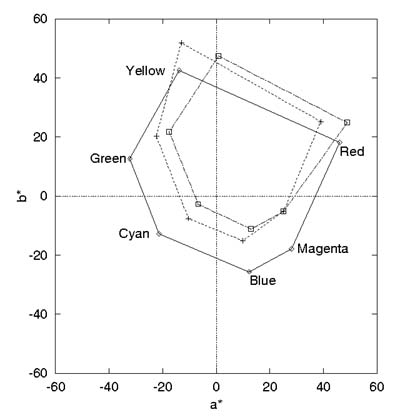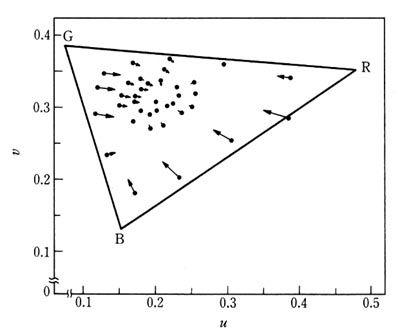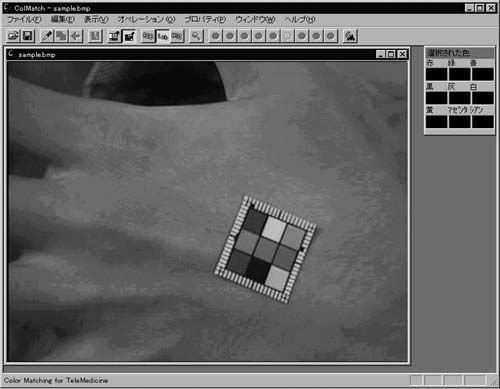[ Document Identification Number : DIN01022816 ]
Digital Color Imaging in Biomedicine (in press), 2001.02.28 (draft)
<http://biocolor.umin.ac.jp/book200102/din01022816.pdf>
Digital Color Imaging in Biomedicine (in press), 2001.02.28 (draft)
<http://biocolor.umin.ac.jp/book200102/din01022816.pdf>
Yasuhiro TAKAHASHI*1 *1CANON INC Office Imaging Products Development Integration Center |
Abstract: In some practical applications of telemedicine, lack of accurate color reproduction is a critical problem. Color transmitted to a distant place and reproduced on a display possibly affected by difference in illumination, characteristics of the camera and modification made during transmission. In this paper, a technique of compensating distorted color is introduced, in which a color chart taken simultaneously with the object is used to adjust color values of displayed images so as to reproduce the same color as the original chart. To calculate compensated color values, a proper formula of determinants, an appropriate look-up table and a color representation system of L*a*b* are used. A computer program is available to perform this process automatically. As telemedicine spreads into various fields of clinical practice, the importance of color compensation is expected to increase. |
1. Introduction Modern information and telecommunications technology has made it easy to transmit moving images, in addition to data and voices, owing to the development of communications equipment and software. Meanwhile, doctors and caregivers are becoming increasingly interested in at-home medicine as society ages. Thus, there are high expectations for telemedicine based on the effective use of information and telecommunications technology. 2. Telemedicine [1] Telemedicine is defined as the medical act of diagnosis and giving instructions to a patient in a remote place, as well as acts associated with medical care, based on the transmission of patient information including images of the patient. Telemedicine has a significant role to play in medical care for the following reasons:
3. Problems on color reproduction in telemedicine systems Regarding images of patients themselves, color reproduction is important in telemedicine. For example, in the case of at-home telemedicine care between a medical institution and a home, delicate changes in the complexion or skin color of an object reproduced on the monitor are important pieces of information to understand the state of health of the patient. However, even in state-of-the-art telemedicine care systems, color reproductivity is not fully taken into consideration, and the colors on the monitor do not provide accurate color information. Accurate color information refers here to the colors of the objects when placed under a standard light. Therefore, doctors must be aware of the fact that the colors on the screen may be different from those of the patient when seen face to face. As a result, doctors have to rely on their experience when checking the colors on their monitor. The causes of color reproduction errors can be divided into the following three main categories. Firstly, there is the problem of how the pictures are taken, as the colors of the object change depending on the type of light and the lighting condition. Fig. 1 illustrates measurements showing how the color values on a color chart change for different types of light. |
| |

|
Secondly, the characteristics of the camera used to photograph or film the object may give rise to color reproduction errors. In order to photograph or film the object while correctly reproducing the color information of R, G, and B, the camera must have sufficient sensitivity to give equivalent color responses as determined by the three primary colors of the monitor. However, since the equivalent color responses have negative portions as shown in Fig. 2, it is not easy to reproduce colors accurately. To solve this problem, the negative portions can be compensated with Epstein approximate values. In this case, if many objects are included in the compensation, then better approximate values can be obtained on the whole. On the other hand, if only a specific object is included, this approximation may lead to a large error. Fig. 3 shows errors produced for various color charts [2].
|

|

|
Thirdly, there are errors associated with the transmission of images. For example, if input signals from the camera are converted to NTSC transmission signals, errors are generated by the processing of these color signals [3]. Image data is sometimes compressed, depending on the transmission speed, and so the original data may not be reproduced from the compressed data and there may be a loss of some color information. The color information on the image of the object displayed on the monitor under the telemedicine care system deviates from the original information because the color data has been distorted under the influence of lighting, photographing or filming, and transmission characteristics. Thus, the goal of color reproduction is always to reproduce colors on the monitor at constant color values without being affected by these characteristics. For this purpose, the color chart of known color values is photographed or filmed together with the object [4]. Color signals from both the object and the color chart are then input to the monitor by the transmission system. The color signals from the object can then be accurately reproduced by compensating the signals from the color chart to produce the same values. In order to compensate the color data, these characteristics must be understood. But since each characteristic depends on some instrument or system, it is impossible for one person to understand all the systems. Therefore, a black-box concept is used to deal with a series of systems in which color signals are taken from photographing or filming of an object, sent by a transmission system, and input to the monitor. 4. Color reproduction 4.1 Diagnosis on conventional images |

| (1) |
Each factor of the matrix is obtained by optimization. As an example, let Yi represent a value of the color chart reproduced on the monitor, and let Zi represent the known value of the color chart, where i = 1,...., n. The least squares method can be used to obtain the matrix G for minimizing E in the following equation.
|

| (2) |
4.2 Color reproduction utilizing a lookup table [5] Color reproduction utilizing a lookup table (LUT) involves preparing beforehand functional values corresponding to a series of variables and compensating for the conversion between two sets of color signals, Y and Z, by using an LUT such as shown in Fig. 4. |

|
If, in a three-dimensional LUT, (n) sample points are to be taken from each of (y1, y2, y3), then the total number of data available for the lattice points is n cubed, and (z1, z2, z3) corresponds to each lattice point. The greater the number of sample points, the more accurate the resulting compensation, but the greater the time required. Usually, therefore, the LUT is constructed with as few sample points as possible. If a converted point is not on a lattice point, the corresponding value is obtained by interpolation. 4.3 Color reproduction considering non-linear distortions of the color space Distortions in the color space in a telemedicine system are very complicated and occur in a non-linear form. The following color reproduction technique was developed that takes into account this fact. A color specification system expressed as L*a*b* is used for compensation. The L* values represent the brightness of color, and the a*b* values represent perceptual chromaticity in which the attributes of brightness and chroma are taken into consideration comprehensively. These values are dealt with independently, and are respectively compensated so that there will be no color difference between the known values of the color chart which has been photographed or filmed together with the object and the values of the color chart reproduced on the monitor. As shown in Fig. 5, the a*b* values are obtained by dividing the a*b* plane into 6 areas, obtaining for each area a compensation matrix (herein, 2x2) described in (1), above, and converting the color values by the respective matrices. The L* values are also compensated for each area. It is time-consuming and not practical to sample the color values of the color chart, one by one, for each image that has been transmitted. Automatic sampling and automatic measuring techniques are essential for the color compensation. We therefore created a software application that performs this automatic color sampling and correction for the color chart. This application (Fig. 6) deals with the entire remote image display system including the lighting system as a black box. Even in clinical practices where telemedicine systems are in place, this application allows conventional systems to be used as they are, simply by handing each patient a color chart. It is thus possible to apply this telemedicine system to many cases of clinical telemedicine care. |

|

|
5. Conclusion Today, telemedicine, including systems that are in the experimental stages, is being put to practical use or being tested at many locations. For at-home telemedicine care mainly dealing with the images of patients themselves, color reproduction errors are an important problem that must be solved. This report explained the causes of color reproduction errors in telemedicine and some color compensation methods to solve the problem. In the future, remote image transmission instruments will be actively used in the clinical fields of internal medicine, dermatology, rehabilitation guidance, and welfare. Patient information has to be acquired accurately, and thus color images will be required, especially in such departments as internal medicine and dermatology as the doctors must deal with clinical and diagnostic problems in their everyday activities. Color compensation techniques will thus become increasingly important in these fields. References
|